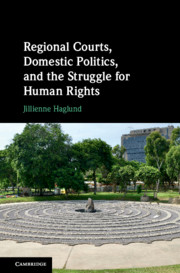Book contents
- Frontmatter
- Dedication
- Contents
- List of Figures
- List of Tables
- Acknowledgements
- 1 Introduction
- 2 Explaining Regional Human Rights Court Deterrence
- 3 Examining Patterns of General Regional Court Deterrence
- 4 Does the Executive have the Capacity to Respond to Adverse Judgments?
- 5 Is the Executive Willing to Respond to Adverse Judgments? The Role of Mass Public Pressure
- 6 Is the Executive Willing to Respond to Adverse Judgments? The Role of Elite Pressure
- 7 Amplified Regional Court Deterrence: High Executive Capacity and High Executive Willingness
- 8 Conclusion
- Appendix A Chapter 3 Appendix
- Appendix B Chapter 4 Appendix
- Appendix C Chapter 5 Appendix
- Appendix D Chapter 6 Appendix
- Appendix E Chapter 7 Appendix
- References
- Index
2 - Explaining Regional Human Rights Court Deterrence
Published online by Cambridge University Press: 01 June 2020
- Frontmatter
- Dedication
- Contents
- List of Figures
- List of Tables
- Acknowledgements
- 1 Introduction
- 2 Explaining Regional Human Rights Court Deterrence
- 3 Examining Patterns of General Regional Court Deterrence
- 4 Does the Executive have the Capacity to Respond to Adverse Judgments?
- 5 Is the Executive Willing to Respond to Adverse Judgments? The Role of Mass Public Pressure
- 6 Is the Executive Willing to Respond to Adverse Judgments? The Role of Elite Pressure
- 7 Amplified Regional Court Deterrence: High Executive Capacity and High Executive Willingness
- 8 Conclusion
- Appendix A Chapter 3 Appendix
- Appendix B Chapter 4 Appendix
- Appendix C Chapter 5 Appendix
- Appendix D Chapter 6 Appendix
- Appendix E Chapter 7 Appendix
- References
- Index
Summary
Chapter 2 develops my theory of regional human rights court deterrence. I begin by defining and explaining regional human rights court deterrence, focusing on two types of deterrence: general and specific. I then discuss two mechanisms of deterrence: prosecutorial and social.The chapter then proceeds by examining the role of the executive in regional court deterrence, specifically the role of the executive in the adoption, administration, monitoring, and enforcement of human rights policy. I argue that human rights policy change is costly for the executive, and as a result, the executive must have the capacity and willingness and respond to adverse regional court judgments with human rights policy change. With respect to capacity, I argue that the executive is more likely to undertake feasible human rights policy changes in response to adverse regional court judgments. I also argue that the executive is more likely to respond to adverse judgments with human rights policy change when the executive has access to outside resources or when the state is fiscally flexible. With respect to willingness, I argue that the executive is more likely to undertake human rights policy change when the executive faces pressure from the mass public, economic elites, or political elites.
Keywords
- Type
- Chapter
- Information
- Publisher: Cambridge University PressPrint publication year: 2020

